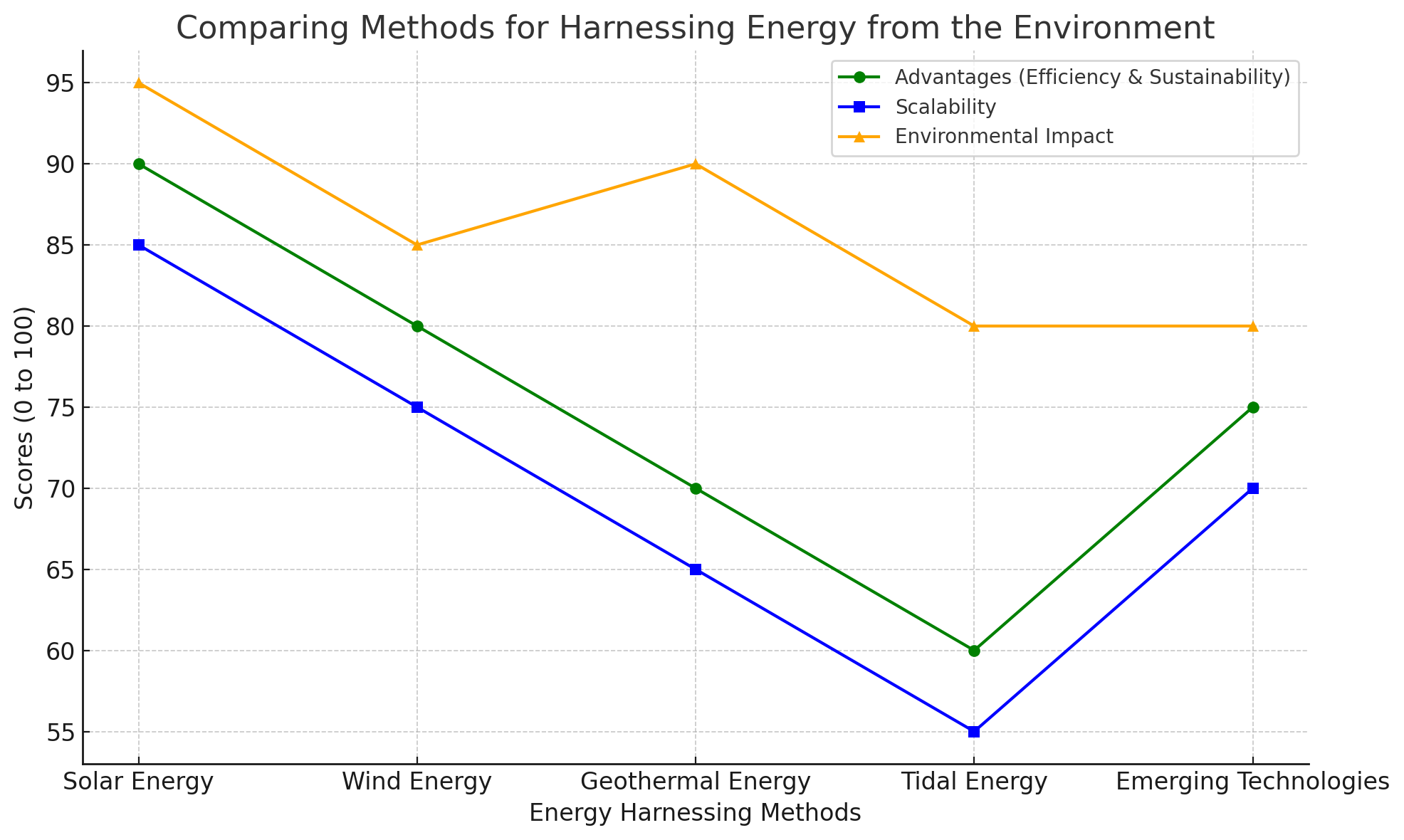
Harness Energy from the Environment: Exploring Sustainable Methods
Energy demands are rising at an unprecedented rate, making it crucial to explore and implement sustainable energy solutions. Harnessing energy from the environment offers a promising path toward reducing dependency on fossil fuels and mitigating the impacts of climate change. This article investigates various methods for harvesting energy from natural sources, including solar, wind, geothermal, tidal, and more, and evaluates their potential for scalability, efficiency, and environmental impact.
Introduction
In today's rapidly changing world, finding ways to harness energy from the environment is no longer just an option; it’s a necessity. As the global population expands and industrialization accelerates, the need for sustainable energy solutions becomes critical. Renewable energy sources like solar, wind, and geothermal hold immense promise. This article dives into how these natural energy resources can be efficiently tapped and the impact they have on environmental sustainability.

Solar Energy: Capturing the Sun's Power
Solar energy is one of the most abundant renewable energy sources available on Earth. The sun radiates more energy in a single hour than the entire world consumes in a year. Harnessing solar energy involves converting sunlight into electricity using photovoltaic (PV) cells or solar thermal systems. These methods are scalable, from small rooftop installations to large solar farms capable of powering entire cities.
Photovoltaic Cells: PV cells convert sunlight directly into electricity by generating a flow of electrons. The technology has evolved significantly over the past few decades, with modern PV panels achieving higher efficiency at lower costs. Residential solar panels are now more accessible, enabling homeowners to reduce their reliance on grid energy while contributing to sustainability.
Solar Thermal Systems: Unlike PV cells, solar thermal systems focus sunlight using mirrors or lenses to produce heat. This heat can be used to generate electricity or for industrial applications. Solar thermal plants are highly efficient and are typically used in large-scale projects where space is not a limitation.
Impact and Challenges: Solar energy significantly reduces carbon emissions, but it has its limitations. Solar panels are dependent on sunlight, meaning energy production varies with weather conditions and time of day. Additionally, large-scale solar farms require significant land, which can impact local ecosystems.
Wind Energy: Harvesting the Power of Wind
Wind energy is another major player in the renewable energy arena. Wind turbines convert kinetic energy from wind into mechanical power, which can then be transformed into electricity. Wind power is highly efficient, especially in areas with consistent wind patterns, such as coastal regions and open plains.
Offshore Wind Farms: Offshore wind turbines are typically more productive than their onshore counterparts due to the higher wind speeds at sea. Offshore wind farms, such as those in the North Sea, have shown immense potential to generate significant amounts of clean energy.
Vertical-Axis Wind Turbines (VAWTs): While traditional wind turbines have horizontal axes, newer VAWT designs offer advantages in areas where wind directions are variable. VAWTs are smaller and easier to maintain, making them ideal for urban environments or areas with less consistent wind.
Environmental Impact: Wind energy has a relatively low environmental footprint. However, challenges include the potential harm to bird populations and noise pollution in nearby communities. Advances in turbine design and placement strategies are helping to mitigate these issues.
Geothermal Energy: Tapping into the Earth's Heat
Geothermal energy utilizes heat from the Earth's core to generate electricity or provide direct heating. It is a highly reliable and sustainable energy source, particularly in regions with active geothermal activity, such as Iceland, where geothermal power accounts for a significant portion of the country's energy supply.
How It Works: Geothermal power plants drill into the Earth’s surface to tap into underground reservoirs of steam and hot water. The heat from these reservoirs can be used to turn turbines and generate electricity. Alternatively, geothermal heat pumps can be installed for residential heating and cooling, reducing the need for fossil fuels.
Efficiency and Challenges: Geothermal energy offers consistent output, unlike solar and wind, which are weather-dependent. However, geothermal plants are location-specific, limiting their widespread adoption. Additionally, the upfront costs of drilling and plant construction can be prohibitive, though the long-term benefits often outweigh these initial expenses.
Tidal and Wave Energy: Power from the Ocean
Tidal and wave energy represent untapped potential in the renewable energy sector. By converting the kinetic energy of ocean currents and waves into electricity, these methods offer a reliable and consistent energy source. Tides are predictable, making tidal energy more reliable than wind or solar.
Tidal Barrages and Turbines: Tidal barrages use a dam-like structure to capture the energy from rising and falling tides, while underwater turbines capture the kinetic energy of tidal flows. Both methods can generate substantial amounts of electricity, especially in areas with large tidal ranges, such as the Bay of Fundy in Canada.
Wave Energy Converters: Wave energy harnesses the power of surface waves to generate electricity. Various devices, such as point absorbers, oscillating water columns, and attenuators, are being tested to determine the most efficient way to capture wave energy.
Challenges and Opportunities: The harsh marine environment poses technical challenges for tidal and wave energy infrastructure. Saltwater corrosion, extreme weather, and the impact on marine life are all concerns that need to be addressed. However, ongoing research and development are making these technologies more viable.
Emerging Technologies: Pushing the Boundaries of Energy Harvesting
In addition to traditional renewable energy sources, emerging technologies are exploring new ways to harness energy from the environment. These technologies are still in development but hold significant promise for the future.
Piezoelectric Energy: Piezoelectric materials generate electricity when subjected to mechanical stress. This technology can be used in urban environments to capture energy from foot traffic, vehicle movements, or even vibrations from buildings. Piezoelectric floors and roads are being tested in various cities to determine their practicality and efficiency.
Artificial Photosynthesis: Inspired by nature, artificial photosynthesis mimics the process by which plants convert sunlight into chemical energy. Researchers are working on creating artificial leaves that can produce fuel from sunlight, water, and carbon dioxide. While still in the experimental phase, this technology could revolutionize the way we generate clean energy.
Atmospheric Energy Harvesting: New research suggests that energy can be harvested from the moisture in the atmosphere. This concept, though still theoretical, could open new doors for energy generation in humid regions or during periods of rain.
Environmental Impact of Harnessing Energy from Natural Sources
One of the greatest advantages of harnessing energy from the environment is the potential to significantly reduce greenhouse gas emissions. Solar, wind, geothermal, and tidal energy sources produce little to no carbon emissions during operation, making them key contributors to a sustainable future.
Challenges: Despite their benefits, renewable energy technologies are not without challenges. Manufacturing and installing renewable energy infrastructure often require significant resources and can have localized environmental impacts. Additionally, the energy storage and transmission systems required to balance intermittent energy sources (such as solar and wind) are still underdeveloped in many regions.
Long-Term Benefits: Despite these challenges, the long-term benefits of renewable energy far outweigh the costs. Transitioning to renewable energy can help reduce air pollution, conserve natural resources, and promote energy independence, leading to a more sustainable and resilient global energy system.
Conclusion: The Future of Energy Harnessing
The methods for harnessing energy from the environment are constantly evolving, offering hope for a future powered by clean, sustainable energy. While solar, wind, and geothermal energy have already proven their viability, emerging technologies like piezoelectric energy and artificial photosynthesis are pushing the boundaries of what’s possible. The environmental and economic benefits of these technologies make them a critical component in the fight against climate change.
As we continue to innovate and improve these technologies, the dream of a fully renewable energy-powered world is becoming increasingly attainable. Now is the time for governments, industries, and individuals to invest in these methods and make the shift towards a more sustainable future.
Environment and Ecology

